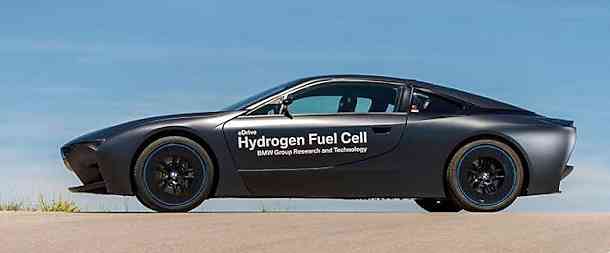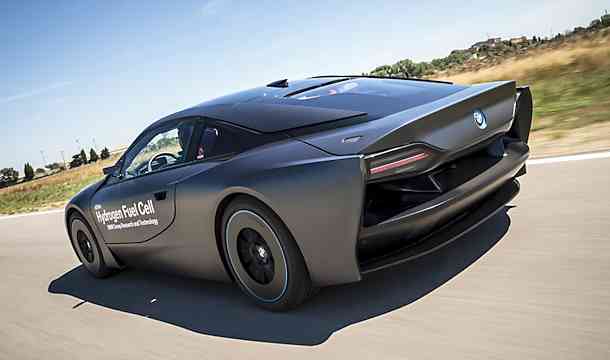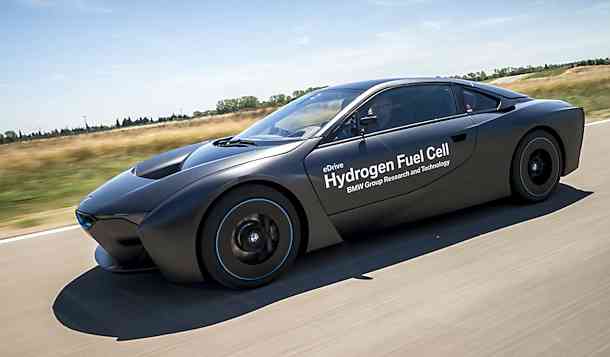
Today, with fuel cell technology now at the point where it can effectively run automobiles, BMW is introducing the i8 Hydrogen car as the first of a new wave of vehicles using this remarkable power source.
However, the BMW i8 Hydrogen is not the first hydrogen powered vehicle that was constructed by BMW. Their history goes back to the Hydrogen 7 which was built in 2005. This particular 7 Series vehicle sported a V12 engine fueled by liquid hydrogen that was kept in a cryogenic tank. Although the vehicle was not considered a success, with celebrities like Jay Leno making purchases, it did get the word out that hydrogen was the fuel of the future.
Today, BMW has created a new line of Fuel Cell Electric Vehicles (FCEV) that uses hydrogen power. Based on the BMW 5 Series and using a 245hp electric motor combined with a high-voltage battery of similar design to the eDrive and iDivision hybrids that plug in for electricity, this new vehicle offers considerable advantages over its predecessors and keeps the tunnel tank that stores the hydrogen between the two axles.
The BMW i8 Hydrogen Car
Developed in a secret facility located in Miramas, France, BMW created the i8 Hydrogen fuel cell vehicle as an extension of their cryogenic pressure storage process used for previous efforts in the field. Because the hydrogen is stored at such a low temperature it helps get the most out of its potential. The operating range of the i8 is around 310 miles which is comparable to most gasoline-powered vehicles of its size. The development of the BMW FCEV was done in cooperation with Toyota which has also made progress in field of hydrogen vehicles rolling out the Mirai for commercial sale in October, 2015.
There are several benefits that this new BMW FCEV brings. One is that the overall range is impressive. A second benefit is that this vehicle can be refueled nearly as fast as a standard gasoline powered car. And a third benefit is that it will go from 0 – 60 mpg in about 6 seconds.

Features
The new i8 BMW Hydrogen fuel cell vehicle offers many familiar features as the new 5 Series GT prototype of this line has demonstrated. The noticeable differences between hydrogen and standard gasoline powered vehicles is the speedometer which is revised to be in sync with the different type of engine and a red emergency stop button which will cut off the system. The central tunnel-type gas tank that holds the hydrogen is not really noticeable, but there are more carbon fiber parts on the roof and lift gate that provide a tougher exterior while being lighter than traditional steel.
The aluminum hydrogen tank is surrounded by steel and wrapped in plastic that is reinforced by carbon fiber. In addition, there is a radiation shield that surrounds the tank as well with welded aluminum casting at the end caps. This is designed to hold the liquid hydrogen in at very low temperatures while keeping it under pressure and protecting it from any impact to the vehicle itself. The surrounding materials combined with the pressure inside means that a tank rupture is a highly unlikely event even in the worst of accidents.
Interestingly enough, despite having a different type of fuel, the actual refilling process is very similar to that of a gas vehicle. You simply open the flap and remove the small cap inside and push the hydrogen hose inside until it locks into place. Once the connection is solid, the tank can be refilled in less than five minutes which is just slightly longer than average for most conventional fuel tanks.
In addition, just like a battery electric vehicle the FCEV is silent when it first starts running. However, this is because the battery makes the vehicle run initially and then the fuel cell kicks in which does make a very slight noise (but much less than an internal combustion engine). One noticeable noise was some hissing when the car is being accelerated to greater speeds, but this is created by the pump passing both hydrogen and air through the stacks of fuel cells.

How the Engine Operates
When you push on the accelerator, the system inside forces the fuel cell stack to push through hydrogen to an anode plate. At this point, the hydrogen is broken down into protons and electrons with the protons going through the polymer cell membranes until they reach the cathode which is positively charged. Then, they will react to the oxygen which will create electricity and then finally steam as a byproduct. This electricity is stored in the accumulator which is a lithium-ion battery that provides the torque and propulsion.
The actual fuel cell stacks come from Toyota and the hydrogen tank, high voltage battery and electric drive train are supplied by BMW. The fuel cell stack will last for about 5,000 hours or 125,000 miles. With 200 to 400 cell-stacks that can be fitted into the engine itself, the number that is present will dictate the power that your vehicle will offer.
In the end, the BMW i8 Hydrogen will be another step towards a revolution in fuel technology. Today, California is preparing to be the first state to have enough hydrogen fuel stations for this type of vehicle. If successful, this model of FCEV and H2 fueling stations will be replicated in other locations inside and outside of the U. S.